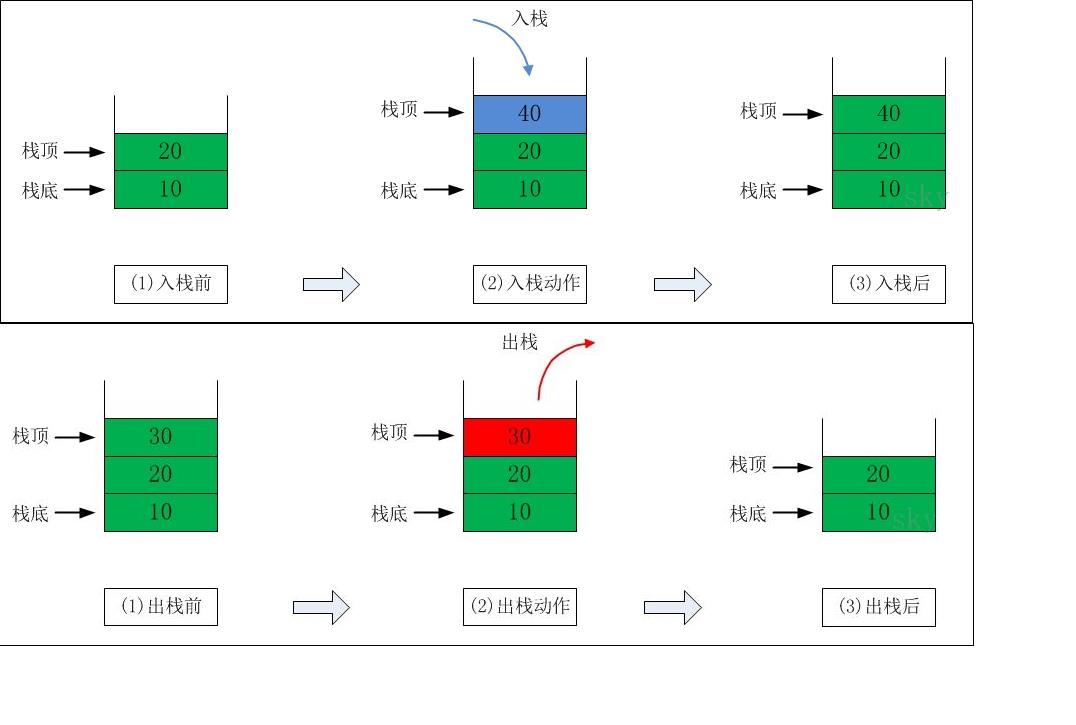栈的介绍与实现
Posted 可乐不解渴
tags:
篇首语:本文由小常识网(cha138.com)小编为大家整理,主要介绍了栈的介绍与实现相关的知识,希望对你有一定的参考价值。
栈的概念
栈的概念
栈是限定仅在表的一端进行插入和删除操作的线性表,允许插入和删除的一端称为栈顶(stack top),另一端称为栈底(stack bottom),不含任何数据元素的栈称为空栈。
压栈:栈的插入操作叫做 压栈 / 入栈。(入数据在栈顶)
出栈:栈的删除操作叫做出栈。(出数据也在栈顶)
换言之,任何时刻出栈或入栈的元素都只能是栈顶元素,即最后入栈者最先出栈,所以栈中元素除了具有线性关系外,还具有后进先出(last int first out)的特性。
栈的结构

栈的实现
栈的初始化
首先,我们需要创建一个栈,这个结构体需要包括栈的基本属性(栈顶、栈的容量)。
这里我们运用顺序表来实现栈。
typedef int StackDataType; //这里我们以整形为例,如需其他类型,可自行更换
typedef struct Stack
{
StackDataType* _array; //动态数组
int _top; //栈顶下标
int _capacity; //容量大小
}stack;
然后,我们需要使用一个函数来对这个刚创建的栈进行初始化。
//栈---动态数组的初始化
void StackInit(stack* pst)
{
assert(pst != NULL);
pst->_array = (StackDataType*)malloc(sizeof(StackDataType) * 4);
if (pst->_array == NULL)
{
printf("初始化失败\\n");
exit(-1);
}
pst->_capacity = 4; //这里我们默认初始化栈的容量为4
pst->_top = 0;
}
栈的销毁
既然有初始化,那就一定会有销毁。 由于我们的栈是由动态数组开辟实现的,所以我们需要把这个动态数组给释放掉,防止内存泄漏。
//销毁
void StackDestory(stack* pst)
{
free(pst->_array);
pst->_array = NULL;
pst->_top = 0;
pst->_capacity = 0;
}
判断栈是否为空
如果栈中元素为空,返回true;否则返回false
//判空
//返回true是空,返回false为非空
bool StackEmpty(stack* pst)
{
assert(pst != NULL);
if (pst->_top == 0)
{
return true;
}
return false;
}
获取栈中数据的个数
int StackSize(stack* pst)
{
assert(pst != NULL);
return pst->_top;
}
获取栈顶元素
因为_top这个位置指向的是栈顶的下一个,所以_top-1指向的是栈顶。
StackDataType StackTop(stack* pst)
{
assert(pst != NULL);
assert(pst->_top > 0);
return pst->_array[pst->_top - 1];
}
入栈
想要入栈首先先判断我们的栈是否已满,如果容量已满,我们需要对起扩容,在把元素入栈。
//入栈
void StackPush(stack* pst, const StackDataType x)
{
assert(pst != NULL);
if (pst->_top == pst->_capacity)
{
pst->_capacity *= 2; //扩充容量至原来的二倍
StackDataType* temp = (StackDataType*)realloc(pst->_array, sizeof(StackDataType) * pst->_capacity);
if (temp == NULL) //如果扩容失败则退出程序
{
printf("扩容失败\\n");
exit(-1);
}
else
{
pst->_array = temp;
}
}
pst->_array[pst->_top] = x;
pst->_top++;
}
出栈
出栈我们首先要判断栈中是否还有元素,才能把栈中的元素进行弹出。
//出栈
void StackPop(stack* pst)
{
assert(pst != NULL);
assert(pst->_top > 0);
--pst->_top;
}
以上是关于栈的介绍与实现的主要内容,如果未能解决你的问题,请参考以下文章